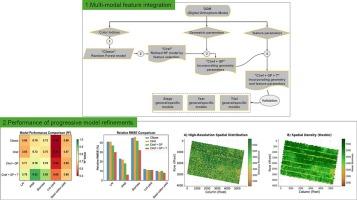Multi-modal feature integration from UAV-RGB imagery for high-precision cotton phenotyping: A paradigm shift toward cost-effective agricultural remote sensing
IF 8.9
1区 农林科学
Q1 AGRICULTURE, MULTIDISCIPLINARY
引用次数: 0
Abstract
Cost-effective remote sensing solutions are critically needed to democratize precision agriculture technologies. While hyperspectral and LiDAR systems deliver high accuracy, their prohibitive costs limit widespread adoption. This study demonstrates that systematic multi-modal feature integration transforms standard UAV-based RGB imagery into a powerful phenotyping instrument, achieving crop trait prediction accuracy comparable to systems costing 10–50 times more. We developed a comprehensive framework integrating spectral indices, geometric parameters, and texture metrics from commodity RGB sensors to predict five critical cotton traits: leaf area index (LAI), intercepted photosynthetically active radiation (IPAR), above-ground biomass, lint yield, and seed cotton yield. The progressive integration approach employed Random Forest regression with four feature configurations: baseline color indices (CIbase), refined color indices (CIref), geometric parameters (CIref + GP), and texture metrics (CIref + GP + T). Field experiments across three trials over two growing seasons (2022–2023) with varying genotypes, planting densities, and sowing dates provided 2,126 ground truth measurements for model development and validation. The optimal multi-modal model achieved R2 = 0.97 for IPAR (rRMSE = 6 %), R2 = 0.91 for LAI (rRMSE = 15 %), and R2 = 0.85 for biomass (rRMSE = 32 %), with lint yield and seed cotton yield demonstrating R2 values of 0.92 and 0.77, respectively. Variance partitioning analysis revealed texture features as the dominant contributor (16.2 % ± 7.1 %), followed by spectral indices (9.1 % ± 4.2 %) and geometric parameters (8.0 % ± 2.8 %), with substantial shared variance (45–65 %) indicating strong feature complementarity. Phenological analysis demonstrated that flowering-stage imagery outperformed boll opening stage measurements, while stage-general models showed superior robustness. Cross-temporal validation confirmed model generalizability, with trial-general models achieving R2 values of 0.91–0.97 for IPAR across diverse environmental conditions. The framework enables sub-meter spatial resolution trait mapping while maintaining operational simplicity and cost-effectiveness, demonstrating that systematic feature engineering can democratize high-precision phenotyping technologies for broader agricultural applications.

无人机- rgb图像的多模式特征集成用于高精度棉花表型分析:向经济高效农业遥感的范式转变
实现精准农业技术的民主化,迫切需要具有成本效益的遥感解决方案。虽然高光谱和激光雷达系统提供高精度,但其高昂的成本限制了其广泛采用。该研究表明,系统的多模态特征集成将标准的基于无人机的RGB图像转换为强大的表型工具,实现作物性状预测精度可与成本高出10-50倍的系统相媲美。我们开发了一个综合光谱指数、几何参数和来自商品RGB传感器的纹理指标的综合框架,以预测棉花的五个关键性状:叶面积指数(LAI)、截获光合有效辐射(IPAR)、地上生物量、皮棉产量和籽棉产量。渐进式集成方法采用随机森林回归,具有四种特征配置:基线颜色指数(CIbase)、精细颜色指数(CIref)、几何参数(CIref + GP)和纹理指标(CIref + GP + T)。在两个生长季节(2022-2023)进行的三个试验中,不同基因型、种植密度和播种日期的田间试验为模型开发和验证提供了2126个地面真实值测量。最优多模态模型对IPAR (rRMSE = 6%)、LAI (rRMSE = 15%)和生物量(rRMSE = 32%)的R2 = 0.97,其中皮棉产量和种棉产量的R2分别为0.92和0.77。方差划分分析显示,纹理特征是主要的影响因子(16.2%±7.1%),其次是光谱指数(9.1%±4.2%)和几何参数(8.0%±2.8%),具有较大的共享方差(45 - 65%),表明特征互补性强。物候分析表明,花期图像优于开铃期测量,而阶段一般模型具有更好的鲁棒性。跨时间验证证实了模型的通用性,在不同环境条件下,IPAR的试验通用性模型的R2值为0.91-0.97。该框架在保持操作简单性和成本效益的同时,实现了亚米级空间分辨率的性状映射,表明系统特征工程可以将高精度表型技术民主化,用于更广泛的农业应用。
本文章由计算机程序翻译,如有差异,请以英文原文为准。
求助全文
约1分钟内获得全文
求助全文
来源期刊

Computers and Electronics in Agriculture
工程技术-计算机:跨学科应用
CiteScore
15.30
自引率
14.50%
发文量
800
审稿时长
62 days
期刊介绍:
Computers and Electronics in Agriculture provides international coverage of advancements in computer hardware, software, electronic instrumentation, and control systems applied to agricultural challenges. Encompassing agronomy, horticulture, forestry, aquaculture, and animal farming, the journal publishes original papers, reviews, and applications notes. It explores the use of computers and electronics in plant or animal agricultural production, covering topics like agricultural soils, water, pests, controlled environments, and waste. The scope extends to on-farm post-harvest operations and relevant technologies, including artificial intelligence, sensors, machine vision, robotics, networking, and simulation modeling. Its companion journal, Smart Agricultural Technology, continues the focus on smart applications in production agriculture.
 求助内容:
求助内容: 应助结果提醒方式:
应助结果提醒方式:


